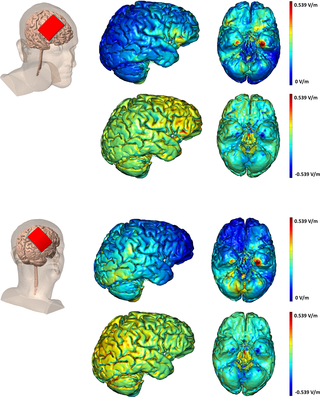
Modeling of current flow when applying 1.5 mA tDCS for F4 anodal (top) and P4 anodal (bottom) stimulation and the cathodal electrode placed on the contralateral cheek.
Important study. 72 older participants, average age 64 showed improvement in working memory tasks but also (and this is a big deal where it comes to cognitive enhancement) significant transfer (where improvements are seen in other tasks not specifically trained for). These results run counter to other recent studies and beg the question of whether the participant’s age was a factor. i.e. Is tDCS more effective for aging brains? That would be a big deal. [See Also: tDCS selectively improves working memory in older adults with more education] And thanks to PLOS ONE we can all read the full paper (linked below)
The results demonstrated that all groups benefited from WM training, as expected. However, at follow-up 1-month after training ended, only the participants in the active tDCS groups maintained significant improvement. Importantly, this pattern was observed for both trained and transfer tasks. These results demonstrate that tDCS-linked WM training can provide long-term benefits in maintaining cognitive training benefits and extending them to untrained tasks.
Interesting, the location of the reference (cathodal) electrode was opposite cheek.
In all conditions, one electrode was placed over the target location at either F4 or P4 (International 10–20 EEG system) and the reference electrode was placed on the contralateral cheek.
via PLOS ONE: Longitudinal Neurostimulation in Older Adults Improves Working Memory.
